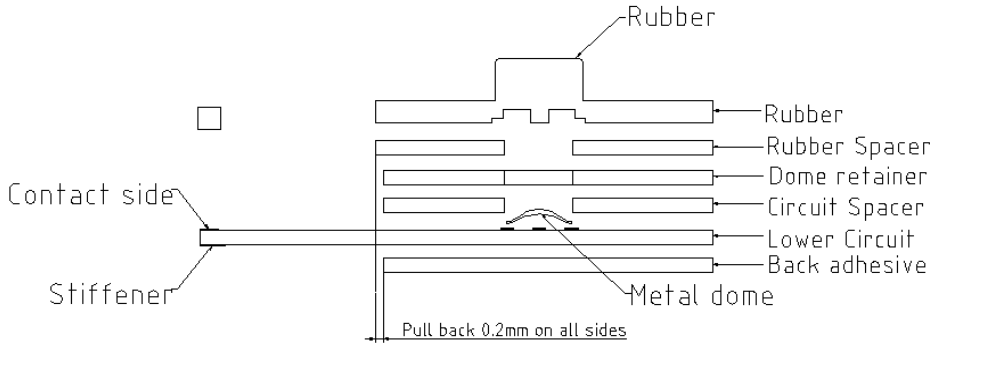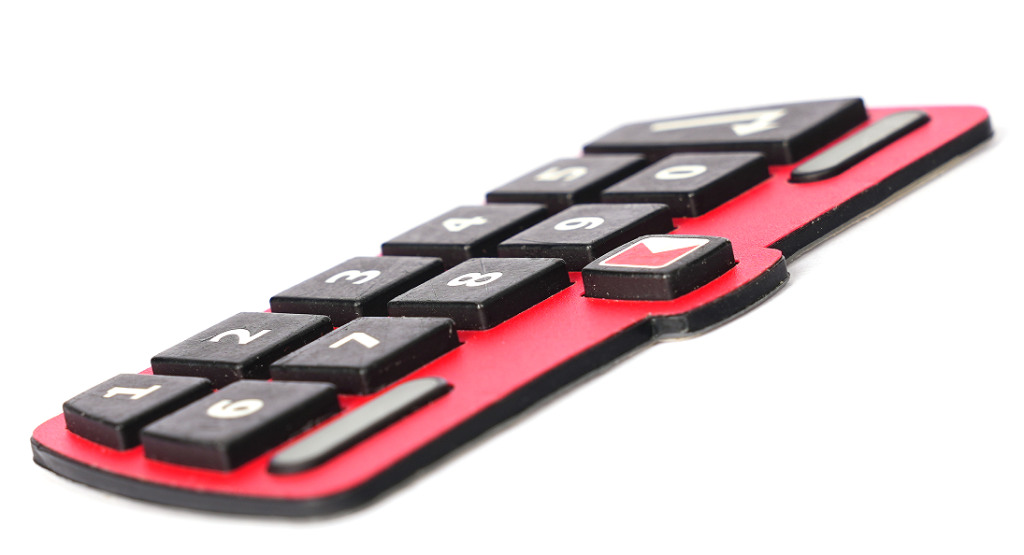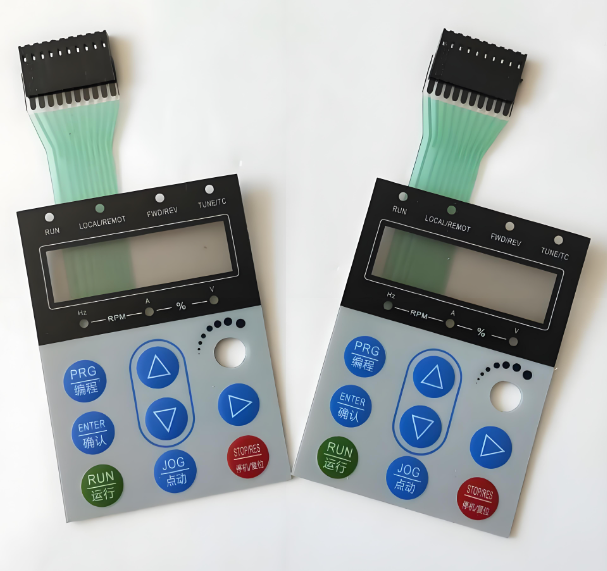
Membrane Button Switch: Advantages & Applications
Membrane Button Switch: Advantages & Applications
A membrane button switch is a widely used input component in various electronic devices, from household appliances to office equipment. These switches are known for their simple design, durability, and affordability. But what makes them so popular? In this blog, we’ll explore what membrane button switches are, how they work, and why they’re a go-to choice for many manufacturers.
What Does a Membrane Button Switch Do?
The primary function of a membrane button switch is to serve as an interface between the user and the device, allowing for input through a simple button press. Different with traditional mechanical switches, membrane switches are made up of several thin layers, which work together to create a simple, yet effective, method for triggering electrical signals.
The design of a membrane button switch is relatively straightforward but functional. It typically consists of three main layers:
- The Top Layer (The Button Layer): This is the outermost layer, which is usually made of flexible material, such as polyester or polycarbonate. It’s where the user interacts with the switch.
- The Conductive Layer (The Circuit): Beneath the top layer, there’s a conductive material like carbon or silver traces that form the electrical circuit. When the button is pressed, the conductive layer is compressed and connects with the underlying layers.
- The Bottom Layer (The Spacer or Backing Layer): This layer typically provides structural support and prevents the conductive and top layers from touching when the button isn’t pressed. Here is a detailed structure of a silicone rubber membrane button switch:

In terms of operation, when the user presses a membrane switch, the top layer of the membrane is pushed down, and the conductive layer touches the underlying contacts, creating a closed circuit. This electrical connection sends a signal to the device’s processor, which interprets the input and executes the corresponding action, such as changing a setting, initiating a function, or sending data.
Can I Put Switches on a Membrane Keyboard?
Yes, you can add switches to a membrane keyboard, though the setup is different from traditional mechanical keyboards. Membrane keyboards typically have built-in switches that are integrated with the flexible membrane. However, some custom modifications allow for tactile switches to be incorporated into the membrane structure, providing a mechanical feel without completely changing the underlying design.
What Is the Advantage of a Membrane Button Switch?
- Membrane switches are typically more affordable to produce than mechanical switches.
- Membrane switches are thin and lightweight, because they don’t require the bulky components of mechanical switches.
- Since they don’t have moving parts, they are less likely to wear out over time, they offer a long lifespan in many applications.
- Their soft, quiet pressing action is perfect for devices that require silent operation, like remote controls or office equipment.
- Membrane button switch is water-resistant and easy to clean.

What Is the Difference Between a Membrane Button Switch and a Mechanical Switch?
While both types of switches serve the same fundamental purpose, there are some notable differences between membrane and mechanical switches. Let me explain it for you.
- Membrane switches use a flexible layer that presses down on a circuit, whereas mechanical switches have individual components like springs and contacts that physically interact when pressed.
- Membrane switches typically offer less tactile feedback compared to mechanical switches. Mechanical switches often provide a satisfying “click” or resistance, which some users prefer for a more responsive typing experience.
- Generally, mechanical switches have a longer lifespan and can withstand more presses than membrane switches. However, membrane switches are more than durable enough for most applications, especially in low-to-medium usage devices.
- Compared with mechanical switch, a membrane switches are much more affordable to produce, which is why they are commonly found in budget-friendly electronics.
Where Are Membrane Switches Used?
Actually, when you look at the appliances in your life, you will find membrane switch in a wide range of devices. Some common applications include:
- From microwaves to washing machines, many household gadgets use membrane switches due to their affordability and ease of cleaning.
- Office device like printers, fax machines, and photocopiers often feature membrane switches for their durability and low maintenance.
- Membrane switches are ideal for medical instruments due to their resistance to dirt and liquids.
- Membrane button switches are often used in remote controls, calculators, and toys.
How to Make a Membrane Keyboard Sound Clicky?
While membrane keyboards are naturally quieter, there are a few tricks you can use to make them sound clicky:
1. Add Dampening Rings: Adding small dampening rings between the membrane and the board can help improve the sound quality, making it feel more mechanical.
2. Modify the Keycaps: Some keycaps are designed to produce more sound. Experiment with different materials or thicknesses to find the one that produces the clickiest sound.
3. Layer a Sound Amplifying Material: Placing a thin layer of material under the keyboard, like foam or rubber, can help amplify the sound and make each keypress more audible.
Although these methods can help make a membrane keyboard sound more clicky, it’s important to remember that the inherent design of membrane switches doesn’t lend itself to the loud, tactile sounds that mechanical keyboards are known for.

Can I Remove Membrane Switches?
Technically, it’s possible to remove membrane switches from some devices, but it’s not always recommended. These switches are integrated into the device’s design, and removing them could damage the circuit or other components. In many cases, replacing the membrane switch requires a full replacement of the membrane layer or circuit board, which can be expensive and complex. If you’re looking to modify your device, it’s always best to consult with a professional.
FAQs
Q1: Are membrane switches suitable for gaming?
A1: Membrane switches aren’t typically favored by gamers who prefer the tactile feedback and speed of mechanical switches. However, membrane keyboards can still perform well for casual gaming.
Q2: How long do membrane button switches last?
A2: Membrane switches can last for millions of presses, but their lifespan is generally shorter than mechanical switches. For most everyday applications, they offer adequate durability.
Q3: Can membrane switches be backlit?
A3: Yes, many membrane switches are designed with backlighting in mind. These types of switches use transparent materials to allow light to pass through, giving the device a modern and sleek look.
Q4: How can I clean membrane button switches?
A4: Membrane switches are easier to clean than mechanical switches. Simply use a soft cloth and mild cleaning solution to wipe away dirt and dust. Avoid harsh chemicals to prevent damage to the membrane layers.
Q5: Are there different types of membrane switches?
A5: Yes, membrane switches come in various forms, including tactile and non-tactile designs, and can be customized to fit specific applications or user preferences.
Membrane button switches are a popular choice for many electronic devices due to their simplicity, affordability, and versatility. They may not offer the same tactile experience as mechanical switches, but they are more than capable of meeting the needs of most users. Whether you’re using them in a remote control, an appliance, or a keyboard, membrane switches provide reliable performance at a lower cost. With a bit of creativity, you can even modify your membrane keyboard to make it sound clicky!
If you’re in the market for membrane switches, look for a reputable supplier like Yuan electronics that can offer high-quality, customizable options to suit your needs.

Know the Difference between Tactile and Non-Tactile Membrane Switching
When selecting the appropriate interface for a product, it can be wise to understand the differences between tactile and non-tactile membrane switches so that the engineer and the purchaser make a better decision. They are both very common in medical equipment, domestic appliances, and industrial equipment, though they do not present the same user experience. ...

Step-by-Step Guide to Selecting the Right Membrane Switch for Your Product
It is not easy to choose the appropriate interface for an electronic device with the number of various types of membrane switches. This is a basic, stepwise analysis to help product designers and manufacturers select the optimal choice. Step 1: Determine your Application Requirements Begin by making a list of locations where switches are used, ...

Top Membrane Switches for Home Electronics Projects in 2025
You can elevate your home electronic membrane switch project in 2025 with standout models such as the 4×4 Matrix 12 Keys Keypad from SOUSHINE, the rgb-enabled strip switches from Molex, and custom graphic switches by Panasonic. These switches offer slim profiles and reliable performance, making them easy to integrate into your DIY setup. You gain ...
Contact us online